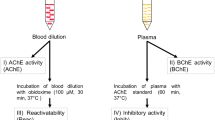Abstract
We measured in nine patients, poisoned by organophosphorus agents (ethyl parathion, ethyl and methyl parathion, dimethoate, or brompphos), erythrocyte and serum cholinesterase activities, and plasma concentrations of the organophosphorus agent. These patients were treated with pralidoxime methylsulphate (ContrathionR), administered as a bolus injection of 4.42 mg.kg−1 followed by a continuous infusion of 2.14 mg.kg−1/h, a dose regimen calculated to obtain the presumed “therapeutic” plasma level of 4 mg.l−1, or by a multiple of this infusion rate. Oxime plasma concentrations were also measured. The organophosphorus agent was still detectable in some patients after several days or weeks. In the patients with ethyl and methyl parathion poisoning, enzyme reactivation could be obtained in some at oxime concentrations as low as 2.88 mg.l−1; in others, however, oxime concentrations as high as 14.6 mg.l−1 remained without effect. The therapeutic effect of the oxime seemed to depend on the plasma concentrations of ethyl and methyl parathion, enzyme reactivation being absent as long as these concentrations remained above 30 μg.l−1. The bromophos poisoning was rather mild, cholinesterases were moderately inhibited and increased under oxime therapy. The omethoate inhibited enzyme could not be reactivated.
Similar content being viewed by others
References
Besser R, Gutman L, Dillmann U, Weilemann LS, Hopf HC (1989) End-plate dysfunction in acute organophosphate intoxication. Neurology 39: 561–567
Boelcke G, Butigan N, Davar H, Erdmann WD, Gaaz JW, Nenner M (1970) Neue Erfahrungen bei der toxicologisch kontrollierten Therapie einer ungewöhnlich schweren Vergiftung mit Nitrostigmin (E605 forteR). Deutsche Mediz Wchschr 95: 2516–2521
Braeckman RA (1982) Kinetische Studie van methylparathion en parathion bij de hond. Doctoral Thesis, University of Ghent School of Pharmacy
Braeckman RA, Godefroot MG, Blondeel GM, Belpaire FM, Willems JL (1980) Kinetic analysis of the fate of methyl parathion in the dog. Arch Toxicol 43: 263–271
Coye MJ, Barnett PG, Midtling JE, Velasco AR, Romero P, Clements CL, Rose TG (1987) Clinical confirmation of organophosphate poisoning by serial cholinesterase analyses. Arch Int Med 147: 438–442
De Kort WL, Kiestra SH, Sangster B (1988) The use of atropine and oximes in organophosphate intoxications: a modified approach. Clin Toxicol 26: 199–208
De Potter M, Muller R, Willems J (1978) A method for the determination of some organophosphorus insecticides in human serum. Chromatographia 11: 220–222
De Schrijver E, De Reu L, Willems J (1985) Determination of methyl paraoxon in dog plasma by reversed-phase high performance liquid chromatography. J Chromatogr 388: 389–395
De Schrijver E, De Reu L, Belpaire F, Willems J (1987) Toxicokinetics of methyl paraoxon in the dog. Arch Toxicol 59: 319–322
Eigenberg DA, Pazdernik TL, Doull J (1983) Hemoperfusion and pharmacokinetic studies with parathion and paraoxon in the rat and dog. Drug Metab Dispos 11: 366–370
Ellman GL, Courtney DK, Andres V Jr, Featherstone RM (1961) A new and rapid colorimetric determination of acetylcholinesterase activity. Bioch Pharmacol 7: 88–95
Erdmann WD, Zech R, Franke P, Bosse I (1966) Zur Frage der therapeutischen Wirksamkeit von Esterase-Reaktivatoren bei der Vergiftung mit Dimethoat. Arzneimittelforschung 16: 492–494
Grob D (1963) Anticholinesterase intoxication in man and its treatment. In: Koelle GB (ed) Cholinesterases and anticholinesterase agents. Handbuch der experimentellen Pharmakologie. Springer Verlag Berlin, Göttingen, Heidelberg, pp 989–1027
Kusic R, Jovanovic D, Randjelovic S, Joksovic D, Todorovic V, Boskovic B, Jokanovic M, Vojvodic V (1991) HI-6 in man: efficacy of the oxime in poisoning by organophosphorus insecticides. Hum Exper Toxicol 10: 113–118
Mahieu P, Hassoun A, Van Binst R, Lauwerijs R, Deheneffe Y (1982) Severe and prolonged poisoning by Fenthion. Significance of the determination of anticholinesterase capacity of plasma. J Toxicol Clin Toxicol 19: 425–432
Mañes-Vinuesa J, Molto Cartés JC, Iguelda Canas C, Font Pérez G (1989) Isolation and concentration of organophosphorus pesticides from water using a C18 reversed phase. J Chromatogr 472: 365–370
Minton NA, Murray VSG (1988) A review of organophosphate poisoning. Med Toxicol 3: 350–375
Namba T, Nolte CT, Jackrel J, Grob D (1971) Poisoning due to organophosphate insecticides. Acute and chronic manifestations. Am J Med 50: 475–492
Nielsen P, Friis C, Gyrd-Hansen N, Kraul I (1991) Disposition of parathion in neonatal and young pigs. Pharmacol Toxicol 68: 233–237
Peña-Egido MJ, Rivas-Gonzalo JC, Mariño-Hernandez EL (1988) Toxicokinetics of parathion in the rabbit. Arch Toxicol 61: 196–200
Senanayake N, Karalliedde L (1987) Neurotoxic effects of organophosphorus insecticides. An intermediate syndrome. N Engl J Med 316: 761–763
Shiloff JD, Clement JG (1987) Comparison of serum concentrations of the acetylcholinesterase oxime reactivators HI-6, obidoxime, and PAM to efficacy against sarin (isopropyl methylphosphonofluoridate) poisoning in rats. Toxicol Appl Pharmacol 89: 278–280
Sundwall A (1961) Minimum concentrations of N-methylpyridinium-2-aldoxime methane sulphonate (P2S) which reverse neuromuscular block. Biochem Pharmacol 8: 413–417
Trundle D, Marcial G (1988) Detection of cholinesterase inhibition, the significance of cholinesterase measurements. Ann Clin Lab Sci 18: 345–352
Willems JL (1981) Poisoning by organophosphate insecticides: analysis of 53 human cases with regard to management and drug treatment. Acta Med Milit Belg 134: 7–14
Willems JL (1992) Pralidoxime methylsulphate in the treatment of organophosphorus poisoning. JEUR (in press)
Willems JL, Langenberg JP, Verstraete AG, De Loose M, Vanhaese-broeck B, Goethals G, Belpaire FM, Buylaert WA, Vogelaers D, Colardyn F (1992) Plasma concentrations of pralidoxime methylsulphate in organophosphorus poisoned patients. Arch Toxicol 66: 260–266
Author information
Authors and Affiliations
Rights and permissions
About this article
Cite this article
Willems, J.L., De Bisschop, H.C., Verstraete, A.G. et al. Cholinesterase reactivation in organophosphorus poisoned patients depends on the plasma concentrations of the oxime pralidoxime methylsulphate and of the organophosphate. Arch Toxicol 67, 79–84 (1993). https://doi.org/10.1007/BF01973675
Received:
Accepted:
Issue Date:
DOI: https://doi.org/10.1007/BF01973675



